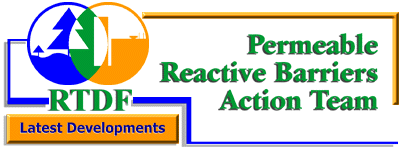 |
|||||||
|
|
|
||||||
|
|
|||||||
 |
|||||||
|
|
|
||||||
|
|
|||||||
|
The information in the following profiles focuses on the use of permeable reactive barriers (PRBs) for ground-water remediation in the United States, Canada, and selected locations abroad. For a summary of information and major lessons learned from the projects profiled, called Field Applications of In Situ Remediation Technologies: Permeable Reactive Barriers, click here. A permeable reactive barrier is a permeable zone containing or creating a reactive treatment area oriented to intercept and remediate a contaminant plume. It removes contaminants from the ground-water flow system in a passive manner by physical, chemical or biological processes. Some PRBs are installed as permanent or semi-permanent units across the flow path of a contaminant plume. Some PRB's are installed as in situ reactors which are readily accessible to facilitate the removal/replacement of reactive media. Most have the reactive media installed or created in intimate contact with the surrounding aquifer material. Included are profiles of ongoing and completed pilot- and full-scale PRB demonstrations as well as full-scale installations. The Table of Contents categorizes the profiles according to the type of contaminants treated. The categories are: Chlorinated Solvents, Metals and Inorganics, Fuel Hydrocarbons, Nutrients, Radionuclides, Other Organic Contaminants. For sites where more than one type of contaminant is treated, the profile is listed under all applicable categories. To the extent it is available, a consistent set of information about each site is presented in the profiles. The intent is to provide potential users of PRB technology with information for making more informed decisions and, when possible, to provide pointers to additional information. The data presented includes site name, location, contaminants treated, characteristics of the site, reactive material(s) used, type of construction, installation date, design cost, installation cost (construction, materials, and the reactive media), results achieved, and point-of-contact for further information. Profiles also include lessons learned and site-specific references, if available. In some cases, photos and graphics related to the site and links to other relevant information also are provided under “More Information.” Sites included were identified by the RTDF Permeable Reactive Barriers Action Team members, and profiles were developed based on information provided by the points-of-contact listed. Additional profiles will be developed as sites are identified. Profiles will be updated periodically, as points-of-contact for each site provide new or expanded information.
|